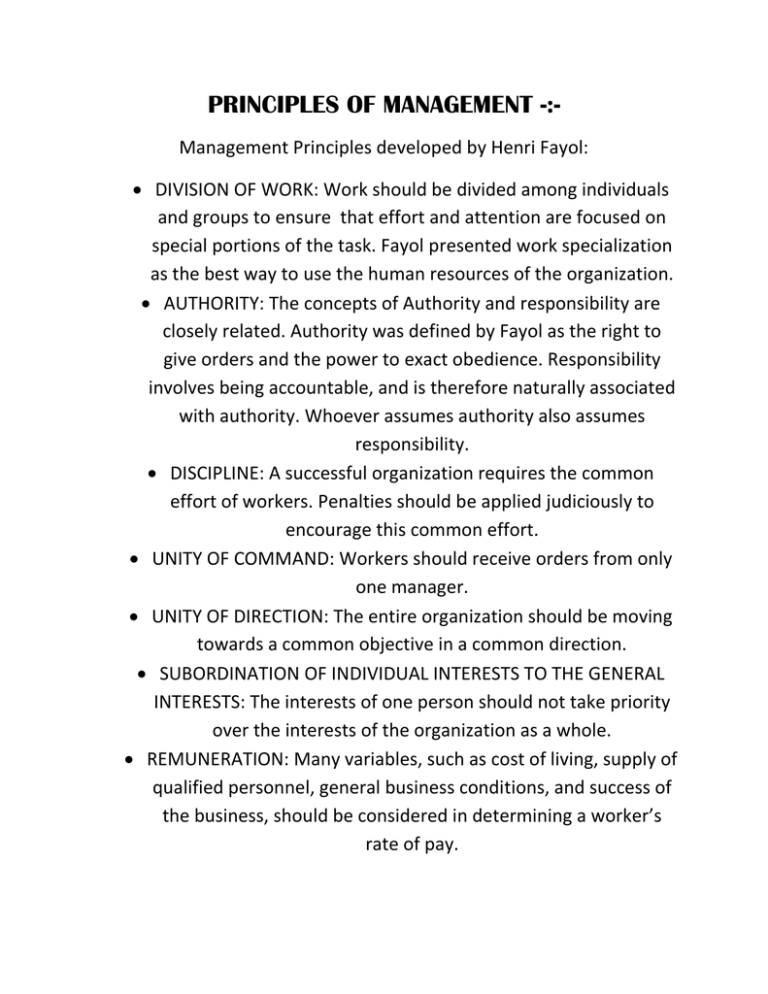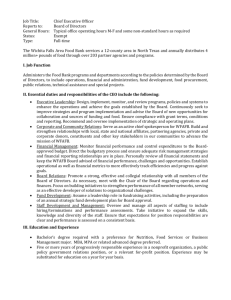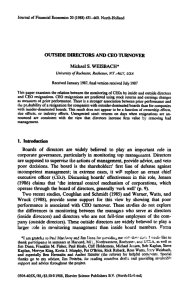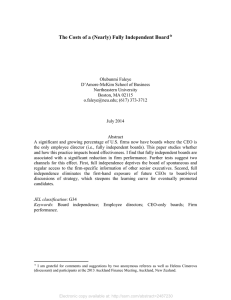MGMT II
advertisement

PRINCIPLES OF MANAGEMENT -:Management Principles developed by Henri Fayol: DIVISION OF WORK: Work should be divided among individuals and groups to ensure that effort and attention are focused on special portions of the task. Fayol presented work specialization as the best way to use the human resources of the organization. AUTHORITY: The concepts of Authority and responsibility are closely related. Authority was defined by Fayol as the right to give orders and the power to exact obedience. Responsibility involves being accountable, and is therefore naturally associated with authority. Whoever assumes authority also assumes responsibility. DISCIPLINE: A successful organization requires the common effort of workers. Penalties should be applied judiciously to encourage this common effort. UNITY OF COMMAND: Workers should receive orders from only one manager. UNITY OF DIRECTION: The entire organization should be moving towards a common objective in a common direction. SUBORDINATION OF INDIVIDUAL INTERESTS TO THE GENERAL INTERESTS: The interests of one person should not take priority over the interests of the organization as a whole. REMUNERATION: Many variables, such as cost of living, supply of qualified personnel, general business conditions, and success of the business, should be considered in determining a worker’s rate of pay. CENTRALIZATION: Fayol defined centralization as lowering the importance of the subordinate role. Decentralization is increasing the importance. The degree to which centralization or decentralization should be adopted depends on the specific organization in which the manager is working. SCALAR CHAIN: Managers in hierarchies are part of a chain like authority scale. Each manager, from the first line supervisor to the president, possess certain amounts of authority. The President possesses the most authority; the first line supervisor the least. Lower level managers should always keep upper level managers informed of their work activities. The existence of a scalar chain and adherence to it are necessary if the organization is to be successful. ORDER: For the sake of efficiency and coordination, all materials and people related to a specific kind of work should be treated as equally as possible. EQUITY: All employees should be treated as equally as possible. STABILITY OF TENURE OF PERSONNEL: Retaining productive employees should always be a high priority of management. Recruitment and Selection Costs, as well as increased productreject rates are usually associated with hiring new workers. INITIATIVE: Management should take steps to encourage worker initiative, which is defined as new or additional work activity undertaken through self direction. ESPIRIT DE CORPS: Management should encourage harmony and general good feelings among employees LEVELS OF MANAGEMENT -:Most organizations have three management levels: firstlevel, middle-level, and top-level managers.[citation needed] These managers are classified in a hierarchy of authority, and perform different tasks. In many organizations, the number of managers in every level resembles a pyramid. Each level is explained below in specifications of their different responsibilities and likely job titles. Top-level managers The top consists of the board of directors (including nonexecutive directors and executive directors), president, vice-president, CEOs and other members of the C-level executives. They are responsible for controlling and overseeing the entire organization. They set a tone at the top and develop strategic plans, company policies, and make decisions on the direction of the business. In addition, top-level managers play a significant role in the mobilization of outside resources and are accountable to the shareholders and general public. The board of directors is typically primarily composed of non-executives which owe a fiduciary duty to shareholders and are not closely involved in the day-to-day activities of the organization, although this varies depending on the type (e.g., public versus private), size and culture of the organization. These directors are theoretically liable for breaches of that duty and typically insured under directors and officers liability insurance. Fortune 500 directors are estimated to spend 4.4 hours per week on board duties, and median compensation was $212,512 in 2010. The board sets corporate strategy, makes major decisions such as major acquisitions,[16] and hires, evaluates, and fires the top-level manager (Chief Executive Officer or CEO) and the CEO typically hires other positions. However, board involvement in the hiring of other positions such as the Chief Financial Officer (CFO) has increased.[17] In 2013, a survey of over 160 CEOs and directors of public and private companies found that the top weaknesses of CEOs were "mentoring skills" and "board engagement", and 10% of companies never evaluated the CEO.[18] The board may also have certain employees (e.g., internal auditors) report to them or directly hire independent contractors; for example, the board (through the audit committee) typically selects the auditor. Helpful skills of top management vary by the type of organization but typically include[19] a broad understanding competition, world economies, and politics. In addition, the CEO is responsible for executing and determining (within the board's framework) the broad policies of the organization. Executive management accomplishes the day-to-day details, including: instructions for preparation of department budgets, procedures, schedules; appointment of middle level executives such as department managers; coordination of departments; media and governmental relations; and shareholder communication. Middle-level managers Consist of general managers, branch managers and department managers. They are accountable to the top management for their department's function. They devote more time to organizational and directional functions. Their roles can be emphasized as executing organizational plans in conformance with the company's policies and the objectives of the top management, they define and discuss information and policies from top management to lower management, and most importantly they inspire and provide guidance to lower level managers towards better performance. Their functions include: Design and implement effective group and inter-group work and information systems. Define and monitor group-level performance indicators. Diagnose and resolve problems within and among work groups. Design and implement reward systems that support cooperative behavior. They also make decision and share ideas with top managers. First-level managers Consist of supervisors, section leaders, foremen, etc. They focus on controlling and directing. They usually have the responsibility of assigning employees tasks, guiding and supervising employees on day-to-day activities, ensuring quality and quantity production, making recommendations, suggestions, and up channeling employee problems, etc. First-level managers are role models for employees that provide: Basic supervision Motivation Career planning Performance feedback IMPORTANCE OF MANAGEMENT -:Managers influence all the phases of modern organizations. Sales Managers maintain a sales force that markets goods. Personnel managers provide organizations with a competent and productive workforce. Plant managers run manufacturing operations that produce the clothes we wear, the food we eat, and the automobiles we drive. Our society could never exist as we know it today nor improve without a steady stream of managers to guide its organizations. The well known management author Peter Drucker highlighted this point when he said that Effective Management is probably the main resource of developed countries and the most needed resource of developing ones. In short, all societies, whether developed or developing, need a huge lot of good managers. THE ROLE OF MANAGEMENT -:Essentially, the role of managers is to guide the organizations toward goal accomplishment. All organizations exist for certain purposes or goals,and managers are responsible for combining and using organizational resources to ensure that their organizations achieve their purposes. The role of the Management is to move an organization towards its purposes or goals by assigning activities that organization members perform. If Management ensures that all the activities are designed effectively, the production of each individual worker will contribute to the attainment of the organizational goals. Management strives to encourage individual activity that will lead to reaching organizational goals and to discourage individual activity that will hinder the accomplishment of the organization objectives. There is no idea more important than managing the fulfillment of the organizational goals and objectives. The meaning of the Management is given by its goals and objectives. All managers, must have a single minded focus on the fulfillment of the organizational goals.








